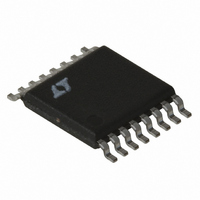LT1956IFE#PBF Linear Technology, LT1956IFE#PBF Datasheet - Page 13

LT1956IFE#PBF
Manufacturer Part Number
LT1956IFE#PBF
Description
IC REG SW 1.5A HV STPDWN 16TSSOP
Manufacturer
Linear Technology
Type
Step-Down (Buck)r
Datasheet
1.LT1956EGNPBF.pdf
(28 pages)
Specifications of LT1956IFE#PBF
Internal Switch(s)
Yes
Synchronous Rectifier
No
Number Of Outputs
1
Voltage - Output
1.2 ~ 45 V
Current - Output
1.5A
Frequency - Switching
500kHz
Voltage - Input
5.5 ~ 60 V
Operating Temperature
-40°C ~ 125°C
Mounting Type
Surface Mount
Package / Case
16-TSSOP Exposed Pad, 16-eTSSOP, 16-HTSSOP
Dc To Dc Converter Type
Step Down
Pin Count
16
Input Voltage
60V
Output Voltage
1.2 to 45V
Switching Freq
540KHz
Output Current
3A
Package Type
TSSOP EP
Output Type
Adjustable
Switching Regulator
Yes
Line Regulation
0.15%/V
Mounting
Surface Mount
Input Voltage (min)
5.5V
Operating Temperature Classification
Automotive
Lead Free Status / RoHS Status
Lead free / RoHS Compliant
Power - Output
-
Lead Free Status / Rohs Status
Compliant
Available stocks
Company
Part Number
Manufacturer
Quantity
Price
APPLICATIO S I FOR ATIO
where:
f = switching frequency
t
V
V
I • R = inductor I • R voltage drop
If this condition is not observed, the current will not be
limited at I
higher value. Using the nominal LT1956 clock frequency
of 500KHz, a V
maximum t
116ns, an unacceptably short time.
The solution to this dilemma is to slow down the oscillator
when the FB pin voltage is abnormally low thereby indicat-
ing some sort of short-circuit condition. Oscillator fre-
quency is unaffected until FB voltage drops to about 2/3 of
its normal value. Below this point the oscillator frequency
decreases roughly linearly down to a limit of about 100kHz.
This lower oscillator frequency during short-circuit condi-
tions can then maintain control with the effective mini-
mum on time. Even with frequency foldback, however, the
LT1956 will not survive a permanent output short at the
absolute maximum voltage rating of V
defined solely by internal semiconductor junction break-
down effects.
For the maximum input voltage allowed during an output
short to ground, the previous equation defining minimum
on-time can be used. Assuming V
0.63V at 1A (short-circuit current is folded back to typical
switch current limit • 0.5), I (inductor) • DCR = 1A • 0.128
= 0.128V (L = CDRH6D28-22), typical f = 100kHz (folded
back) and typical minimum on-time = 300ns, the maxi-
mum allowable input voltage during an output short to
ground is typically:
Increasing the DCR of the inductor will increase the maxi-
mum V
also drop overall efficiency during normal operation.
Every time the converter wakes up from shutdown or
undervoltage lockout to begin switching, the output
ON
F
IN
V
V
= diode forward voltage
= switch minimum on time
= input voltage
IN
IN(MAX)
= (0.63V + 0.128V)/(100kHz • 300ns)
IN
allowed during an output short to ground but will
PK
ON
= 25V
, but will cycle-by-cycle ratchet up to some
to maintain control would be approximately
IN
of 12V and a (V
U
U
F
+ I • R) of say 0.7V, the
W
F
(D1 catch diode) =
IN
= 60V; this is
U
capacitor may potentially be starting from 0V. This re-
quires that the part obey the overall duty cycle demanded
by the loop, related to V
rises to its target value. It is recommended that for [V
(V
to control the output capacitor charge rate during start-up
or during recovery from an output short circuit, thereby
adding additional control over peak inductor current. See
Buck Converter with Adjustable Soft-Start later in this
data sheet.
OUTPUT CAPACITOR
The LT1956 will operate with either ceramic or tantalum
output capacitors. The output capacitor is normally cho-
sen by its effective series resistance (ESR), because this
is what determines output ripple voltage. The ESR range
for typical LT1956 applications using a tantalum output
capacitor is 0.05 to 0.2 . A typical output capacitor is an
AVX type TPS, 100 F at 10V, with a guaranteed ESR less
than 0.1 . This is a “D” size surface mount solid tantalum
capacitor. TPS capacitors are specially constructed and
tested for low ESR, so they give the lowest ESR for a given
volume. The value in microfarads is not particularly criti-
cal, and values from 22 F to greater than 500 F work well,
but you cannot cheat mother nature on ESR. If you find a
tiny 22 F solid tantalum capacitor, it will have high ESR,
and output ripple voltage will be terrible. Table 3 shows
some typical solid tantalum surface mount capacitors.
Table 3. Surface Mount Solid Tantalum Capacitor ESR
and Ripple Current
E CASE SIZE
AVX TPS, Sprague 593D
D CASE SIZE
AVX TPS, Sprague 593D
C CASE SIZE
AVX TPS
Unlike the input capacitor, RMS ripple current in the
output capacitor is normally low enough that ripple cur-
rent rating is not an issue. The current waveform is
triangular with a typical value of 125mA
to calculate this is:
OUT
+ V
F
)] ratios > 4, a soft-start circuit should be used
IN
ESR (MAX,
and V
0.1 to 0.3
0.1 to 0.3
0.2 (typ)
LT1956/LT1956-5
OUT
, as the output voltage
)
RIPPLE CURRENT (A)
RMS
. The formula
0.7 to 1.1
0.7 to 1.1
0.5 (typ)
13
1956f
IN
/













